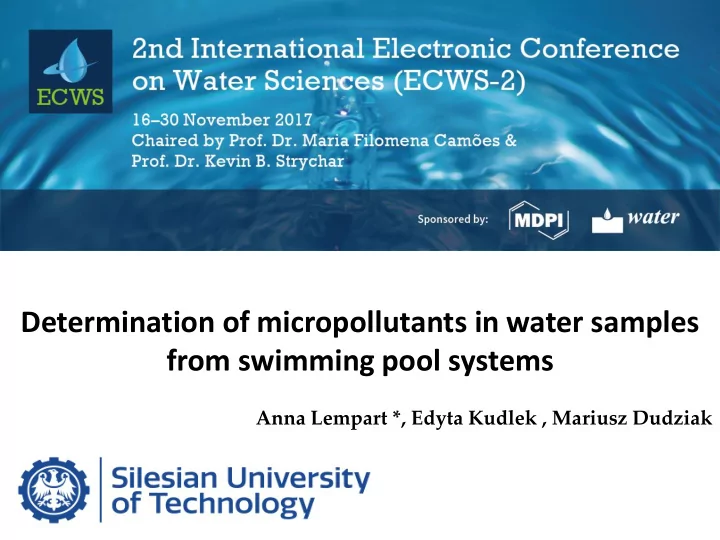

Determination of micropollutants in water samples from swimming pool systems Anna Lempart *, Edyta Kudlek , Mariusz Dudziak
INTRODUCTON Research on PPCPs in swimming pools are still in their infancy and available data are limited. PPCPs are designed to be biologically active even at low concentrations. Long-term exposure to the PPCPs mixture may potentially cause negative health effects. PPCPs ’ degradation in swimming pool water treatment systems is possible and their by-products may be more relevance to the health of swimmers than their parent compound
INTRODUCTON Swimmers have direct contact with the compounds present in the swimming pool water and their by-products
INTRODUCTON The determination of PPCPs requires very sensitive analytical methods that enables to confirm the presence of tested compounds in a complex organic extract. This study presents a selection of procedure for determining the concentration of three compounds from the macro-group of Pharmaceutical and Personal Care Products.
Extraction conditions selection SPE – Solid Phase Extraction The operating parameters selection NIST 17 Mass Spectral Library GC/MS - Gas Chromatograph with Mass Detector
MATERIALS AND METHODS Table 1. Characteristics of tested compounds Structural Molecular Molar Mass Standard CAS Number Purity formula formula [g/mol] Caffeine C 8 H 10 N 4 O 2 194.19 58-08-2 > 99% (CAF) Benzophenone-3 C 14 H 12 O 3 228.24 131-57-7 98% (BP-3) Carbamazepine C 16 H 12 N 2 O 236.27 298-46-4 >99% (CBZ)
MATERIALS AND METHODS Table 2. Characteristics of Supelclean ™ Tubes applied to Solid Phase Extraction Bed Carbon Tube Tube Volume Weight Loading Bed Type Type [mL] [g] [%] ENVI-8 1 6 14 C8 (octyl) 6 ENVI-18 1 17 C18 (octadecyl) 6 LC-8 0.5 7 C8 (octyl) 6 LC-18 1 11.5 C18 (octadecyl) 6 LC-CN 0.5 7 Cyano LC-Ph 0.5 3 5.5 Phenyl
RESULTS – The determined operating GC-MS (EI) parameters Injector: Ion source: 250 o C 230 o C The support phase: Ion trap: helium with a flow 150 o C of 1.1 mL/min The oven temperature Ion recording program: mode: 80 ° C (6 min), 50 ÷ 700 m/s 5 ° C/min to 260 ° C, 20 ° C/min to 300 ° C
RESULTS - The linearity of mass detector response (a) (b) (c) Figure 1. Calibration curve by GC-MS for (a) CAF, (b) BP-3, (c) CBZ
RESULTS - The linearity of mass detector response Table 3. The parameters of calibration curves for determining micropollutants by GC-MS t R ± SD R 2 Standard a S a b S b 19.37 ± 0.01 2 000 000 316 802 -677 705 459 921 0.99 CAF 22.46 ± 0.02 0.99 35 504 2 019 -20 739 2 931 BP-3 24.19 ± 0.02 0.95 766 841 295 337 936 453 428 759 CBZ The obtained values of R2 coefficient show the linearity of the detector ’s response. Retention times of compounds allow for proper separation and appropriate identification in complex water matrices. The standard deviations of t R are acceptable.
RESULTS - The repeatability of the measurements Table 4. Coefficient of Variation (CV) for five concentration levels of tested micropollutants CV [%] LOD Standard [ng/L] 0.5 ng/ μl 1.0 ng/ μl 2.0 ng/ μl 5.0 ng/ μl 10.0 ng/ μl 2.25 CAF 0.66 1.39 1.81 1.67 0.02 0.95 BP-3 1.32 1.41 2.28 2.08 0.02 1.66 CBZ 2.81 2.89 2.68 1.59 0.10 The LOD determines the lowest quantity of a substance that can be distinguished from the absence of that substance within a stated confidence limit The obtained values of CV do not exceed 3% that confirm the high repeatability of conducted measurements.
RESULTS - Recovery and LOQ for various combinations of SPE Tube types and the solvents Chosen as the most optimal methodology
RESULTS – Recoveries in different matrices Table 6 . Recoveries obtained in the most optimal Solid Phase Extraction methodology (Methanol + Acetonitrile and ENVI-18 Tube) for different matrices Recovery ± SD [%] Matrix CAF BP-3 CBZ Deionized water 100 ± 2.4 100 ± 9.9 100 ± 10.0 Tap water 92.5 ± 2.8 95.7 ± 1.2 98.4 ± 8.2 Swimming pool water 100 ± 2.2 100 ± 5.9 100 ± 5.4 Based on the calculated recovery factors, the accuracy of the results obtained from the chosen analytical method was very good. The repeatability of the results measured as the standard deviation was satisfactory, its value was in the range from 1 to 10%.
RESULTS - the recoveries of the selected as the best conditions of Solid Phase Extraction for the various matrices Table7 . Limits of Quantification obtained in the most optimal Solid Phase Extraction methodology (Methanol+Acetonitrile and ENVI-18) for different matrices LOQ [ng/L] Matrix CAF BP-3 CBZ Deionized water 0.84 0.95 0.87 Tap water 0.78 0.88 0.83 Swimming pool water 0.69 0.75 0.71 The lowest LOQs were obtained for swimming pool water, while the highest were observed for deionized water. The observed differences show the influence of the organic and inorganic substances presence in the water matrix on the LOQ value.
CONCLUSIONS The presented analytical procedure enables the quantification of caffeine, carbamazepine and benzophenone-3 with satisfactory repeatability and accuracy. The obtained recovery values ensure the possibility of full quantitative control of the tested micropollutants in samples collected from swimming pool waster systems. The developed methodology can be used for analytical control of swimming pool water treatment processes from selected Pharmaceuticals and Personal Care Products. The different physicochemical composition of water affect on LOQ. The values of LOQ obtained for swimming pool water were lower than for deionized and tap water.
Recommend
More recommend